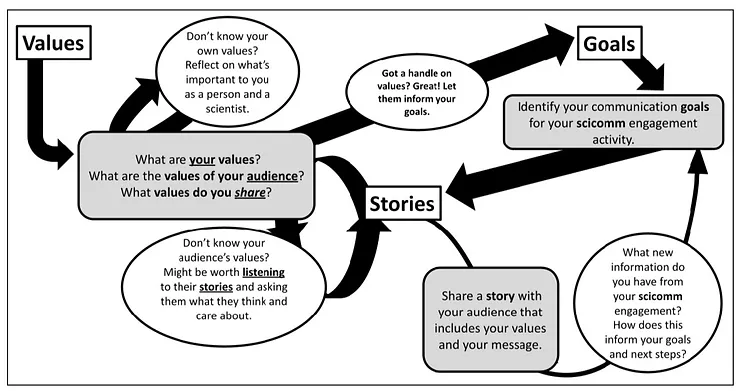Finding the pearls: a practical approach for effective science storytelling
By Carolyn Pralle
Title: Sharing science through shared values, goals, and stories: an evidence-based
approach to making science matter
Author(s) and Year: Bethann Garramon Merkle, Evelyn Valdez-Ward, Priya Shukla, Skylar R. Bayer; Published in 2021
Journal: Human-Wildlife Interactions (Open Access)
| TL;DR: To communicate science meaningfully, scientists should do three things to connect with their target stakeholders: 1) center shared values, 2) clearly express sci-comm goals, and 3) use the power of stories. Why I chose this paper: Developing narratives puts me out of my comfort zone as a writer (give me poetry with weird metaphors!) but I savor good storytelling, especially about science. I appreciated this article’s practical and evidence-based approach. |
Scientists are like oysters. In an ocean of ideas, scientists sieve and experiment with their research projects, building on the foundations and results of one another’s work. Sometimes, an idea comes with a piece of grit: the seed of a story. That piece of grit gets coated in layers of meaning and experience, potentially becoming a pearl—a.k.a. a science story! Using a framework for science storytelling can help scientists share those pearls with stakeholders in effective and meaningful ways.
The Details
The Background
Many scientists know it’s unrealistic to persuade people with data, but it can be difficult to communicate outside the familiar paradigm of communicating science through empirical results. Offering an alternative framework, Merkle, Valdez-Ward, Shukla, and Bayer, four biologists and sci-comm researchers from across the United States, describe a practical evidence-based approach designed to encourage more effective science communication.
The authors’ framework includes three essential components: shared values, clear goals, and organized stories. The authors provide a conceptual flow chart (Figure 1) for scientists to document their values, goals, and stories. The flowchart illustrates a pattern of interconnected questions and prompts for scientists to identify their values, then goals, then develop a related story. The authors also suggest resources and a supplemental worksheet to help scientists use this framework.

Key Terms
The authors deliberately define and contextualize several key terms in sci-comm used in relation to their framework (Table 1 ). They advise scientists to avoid overusing jargon (technical words and phrases) and to explain scientific norms, as needed, with stakeholders.
Table 1: Key Terms Used in Merkle et al.’s 2021 Science Storytelling Framework
| Key Term | Authors’ Meaning |
| scientist | Anyone involved in producing, disseminating, or applying science (can be from academia or not) |
| science communication | Umbrella term for discourse connecting scientists with people outside of academic or field-specific circles |
| audience vs. stakeholder | Audiences are passively engaged or talked at by scientistsStakeholders are actively engaged and collaborating with scientists throughout multiple stages of the work |
| deficit model | A sci-comm model that assumes people lack information and change their minds when provided enough data |
| dialogue and co-production approaches | Scientists talk with and listen to stakeholders Stakeholders and scientists co-produce research on a long-term basis, all parties are responsive to feedback |
| good sci-comm | Evidence-based, fully inclusive, and accessible Involves methods to track impacts and outcomes |
Three Parts to the Framework: Values, Goals, Stories
Values
Although scientists are often trained to withhold personal matters from their work, personal and cultural experiences inherently influence the ways they communicate. This framework encourages scientists to use a personal and transparent approach that builds trust among scientists and stakeholders, establishing shared values between groups. Trust is often lacking because stakeholders (as well as Indigenous communities who may reject the title “stakeholder”) have historically been overlooked or prohibited from sharing their expertise and values with scientists. The authors provide worksheets (see Supplement 1) to identify their core values as scientists and find overlap with the values of target stakeholders.
Goals
An essential part of this framework is setting clear, measurable goals for their science communication. The authors recommend “backwards design” as a tactic, which involves: 1) identifying goals first, and 2) working backwards to figure out how to achieve them. The authors compare this backward design process of setting sci-comm goals to deciding hypotheses and statistical analyses before conducting research. The backwards design process becomes a cycle as projects evolve and iterate over time. The authors offer recommended actions and resources for developing goals, connecting the goals to their values (and the values/goals of their target stakeholders), and creating a timeline for carrying out the goals.
Stories
Unlike data and facts, stories possess the power to change minds. Stakeholders can relate the content of a story to their own personal experiences, especially when the story connects to their values and goals. Stories can shift views even on controversial topics like vaccination or climate change.
The authors recommend using stories with rich details and emotional connections, even when writing scientific manuscripts. They suggest outlining five essential characteristics: 1) the stakes 2) the teller’s connection, 3) the climax or conflict, 4) detailed characters , and 5) a clear beginning, middle, and end. Finally, the authors recommend preparing multiple drafts, testing the story on a variety of readers/listeners, and considering how stakeholders may or may not relate to the story.
The Impact
This framework demands considerable planning and diligence for scientists to articulate their values, goals, and stories while overcoming challenges like time constraints and limited opportunities for good sci-comm training. Yet, the challenge may be worth the reward. By using this framework as a communications tool, scientists can more effectively communicate their science to build satisfying, collaborative, long-lasting relationships with stakeholders.
Edited by Iris Du and Niveen AbiGhannam
Cover image credit: PxHere

